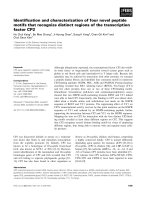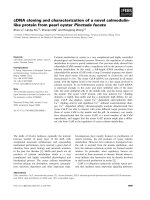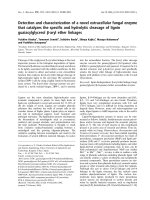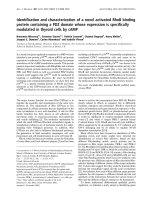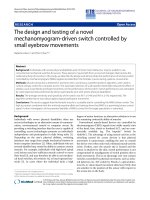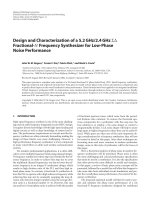Design and characterization of functional novel oligopeptides
Bạn đang xem bản rút gọn của tài liệu. Xem và tải ngay bản đầy đủ của tài liệu tại đây (1.7 MB, 95 trang )
DESIGN AND CHARACTERIZATION OF FUNCTIONAL
NOVEL OLIGOPEPTIDES
ONG BOON TEE
(B.Sc. (Hons.), NUS)
A THESIS SUBMITTED
FOE THE DEGREE OF MASTER OF SCIENCE
DEPARTMENT OF CHEMISTRY
NATIONAL UNIVERSITY OF SINGAPORE
2003
PDF created with FinePrint pdfFactory Pro trial version www.pdffactory.com
DESIGN AND CHARACTERIZATION OF FUNCTIONAL
NOVEL OLIGOPEPTIDES
ONG BOON TEE
(B.Sc. (Hons.), NUS)
A THESIS SUBMITTED
FOE THE DEGREE OF MASTER OF SCIENCE
DEPARTMENT OF CHEMISTRY
NATIONAL UNIVERSITY OF SINGAPORE
2003
PDF created with FinePrint pdfFactory Pro trial version www.pdffactory.com
ACKNOWLEDGEMENT
I would like to acknowledge Dr. Suresh Valiyaveettil for his guidance and advice
throughout my Master’s research work. I would like to give my warmest gratitude to the
following laboratory technicians: Ms Tang Chui Ngoh for her help with the SEM
machine, Ms Kho Say Tin from the Department of Biological Sciences for her help with
the HPLC and ESI-MS machine. A special thank to Assoc. Prof. Xu Guo Qin in allowing
me to use the AFM machine in his laboratory.
Next, I would like to thank my personal friend, Ms Michelle Low Bee Jin, in her help
with the instruments when it’s faulty and also her encouragement and support during the
duration of my Master’s research program.
A special thanks to the following post-docs, Dr. Parayil Kumaran Ajikumar and Dr.
Lakshminarayanan Rajamani, in their helpful and invaluable advice and encouragement
during the course of my research. I would also like to extend my gratitude to the other
postgraduate students and postdoctoral fellows in the group whom have in one way or
another contributed their knowledge and help in the course of my research.
Finally, I like to thank my family members for being there for me when I needed them
most for their support and encouragement.
PDF created with FinePrint pdfFactory Pro trial version www.pdffactory.com
TABLE OF CONTENTS
Acknowledgement
Table of Contents
i
List of Abbreviations
iv
List of Tables
vi
List of Schemes
vi
List of Figures
vii
Summary
x
Chapter 1: Introduction
1
1.1
Introduction
2
1.2
Self-Assembly
2
1.3
Biomineralization
5
1.4
Outline of Thesis
1.5
1.4.1 Aim and scope of present work
12
References
13
Chapter 2: Synthesis and Characterization of Self-Assembly
Peptides
18
2.1
19
Materials and Methods
-iPDF created with FinePrint pdfFactory Pro trial version www.pdffactory.com
2.2
Solid-Phase Peptide Synthesis
19
2.3
Purification and Characterization of Peptides
23
2.4
Self-Assembly of Peptides
25
2.4.1 Dynamic Light Scattering (DLS)
25
2.4.2 Circular Dichroism (CD) Experiments
26
2.4.3 Atomic Force Microscopy (AFM)
27
2.5
Calcium Carbonate Crystallization Assay
27
2.6
Energy-Dispersive X-ray Scattering (EDXS)
30
2.7
Powder X-ray Diffraction (XRD)
30
2.8
References
30
Chapter 3: Results and Discussion
32
3.1
Introduction
33
3.2
Synthesis, Purification and Characterization of Peptides
34
3.3
Solution and Solid-state Structures of Synthetic Peptides (P1-P4)
36
3.3.1 Dynamic Light Scattering (DLS) studies
36
3.3.2 Circular Dichroism (CD) studies
41
3.3.2.1
In water
41
3.3.2.2
In 10 mM CaCl2 solution
43
3.3.2.3
Effect of salt solutions on solution conformations of
3.3.2.4
the peptides
45
pH dependent
47
- ii PDF created with FinePrint pdfFactory Pro trial version www.pdffactory.com
3.4
Atomic Force Microscopy Studies of the peptides (P1 – P4)
49
3.4.1 In water at high concentration (1 mg/ml) of the
peptides at pH ∼ 3 and 5
3.4.2 Influence of salt solutions on the self-assembly of peptides
3.5
3.6
49
57
Effects of the calcite crystals morphologies in the presence of peptides
3.5.1 Scanning Electron Microscopy (SEM)
64
3.5.2 Energy Dispersive X-Ray Scattering (EDXS)
72
3.5.3 Powder X-Ray Diffraction (XRD)
73
References
74
Chapter 4: Conclusions
77
4.1
Conclusion
78
4.2
References
80
- iii PDF created with FinePrint pdfFactory Pro trial version www.pdffactory.com
List of Abbreviations
A
0.1 % TFA in water
ACN
acetonitrile
AFM
atomic force microscopy
Ala (A)
alanine
Arg (R)
arginine
Asp (D)
aspartic acid
B
0.1 % TFA in 80 % acetonitrile
CD
circular dichroism
DLS
dynamic light scattering
EDXS
energy dispersive X-ray scattering
ESI-MS
Electrospray Ionisation Mass Spectroscopy
Fmoc
9-Fluorenylmethoxycarbonyl
Glu (E)
glutamic acid
Gly (G)
glycine
h
hours
HATU
2-(1H-9-Azabenzotriazole-1-yl)-1,1,3,3tetramethyluronium hexafluorophosphate
Ile (I)
isoleucine
Leu (L)
leucine
Lys (K)
lysine
µg
micro gram
- iv PDF created with FinePrint pdfFactory Pro trial version www.pdffactory.com
µL
micro litre
mdeg
milli degrees
mg
milli gram
mL
milli litre
nm
nanometer
PAL
5-(4-Aminomethyl-3,5-dimethoxyphenoxy)valeryl
Phe (F)
phenylalanine
pI
isoelectric point
Proline (P)
proline
RP-HPLC
reversed phase high-pressure liquid chromatography
SEM
scanning electron microscopy
SPPS
solid-phase peptide synthesis
TFA
trifluoroacetic acid
TIPS
triisopropylsilane
UV-CD
ultraviolet circular dichroism
XRD
X-ray diffraction
-vPDF created with FinePrint pdfFactory Pro trial version www.pdffactory.com
List of Tables
Chapter 3
Table 1
Amino acid sequence, theoretical and observed masses and
35
percentage yield of the synthetic peptides
Table 2
Quantitative analysis of the peptides at 1 mg/mL in water using
42
CDNN software
Table 3
Quantitative analysis of the peptides at 2 mg/mL in 10 mM
44
CaCl2 solution using CDNN software
Table 4
Quantitative analysis of the peptides at 1 mg/mL in 10mM
46
NaCl and CaCl2 solution respectively
Table 5
Quantitative analysis of the peptides at 1 mg/mL in water at
48
pH ∼ 3 and 5
List of Schemes
Chapter 2
Scheme 1
Mechanism involved in the formation of the calcium carbonate
29
crystals
- vi PDF created with FinePrint pdfFactory Pro trial version www.pdffactory.com
List of Figures
Chapter 2
Figure 1
General scheme for Fmoc chemistry
22
Figure 2
Experimental set-up for calcite crystallization in the presence
29
of peptides
Chapter 3
Figure 3
Purification of the peptides using RP-HPLC
35
Figure 4
Particle size distributions of the peptides (P1 to P4) in water
37
obtained by DLS at pH ~ 3 and 5
Figure 5
Particle size distributions of the peptides (P1 to P4) in 10 mM
39
CaCl2 and NaCl solutions obtained by DLS
Figure 6
CD spectra of the peptides (P1 to P4) in water at various
41
concentrations
Figure 7
CD spectra of the peptides (P1 to P4) in 10 mM CaCl2 solution
43
at various concentrations
Figure 8
CD spectra of the peptides (P1 to P4) at 1 mg/ml in 10 mM
45
NaCl and CaCl2 solution respectively
Figure 9
CD spectra of the peptides (P1 to P4) at 1 mg/ml in water at
47
pH ~ 3 and 5 at 25 °C
- vii PDF created with FinePrint pdfFactory Pro trial version www.pdffactory.com
Figure 10
AFM images of P1 adsorbed onto mica substrate from water
49
at pH ~ 3 and 5
Figure 11
AFM images of P2 adsorbed onto mica substrate from water
51
at pH ~ 3 and 5
Figure 12
AFM images of P3 adsorbed onto mica substrate from water
53
at pH ~ 3 and 5
Figure 13
AFM images of P4 adsorbed onto mica substrate from water
55
at pH ~ 3 and 5
Figure 14
AFM images of P1 adsorbed onto mica substrate from 10 mM
57
CaCl2 and NaCl salt solutions
Figure 15
AFM images of P2 adsorbed onto mica substrate from 10 mM
58
CaCl2 and NaCl salt solutions
Figure 16
AFM images of P3 adsorbed onto mica substrate from 10 mM
60
CaCl2 and NaCl salt solutions
Figure 17
AFM images of P4 adsorbed onto mica substrate from 10 mM
61
CaCl2 and NaCl salt solutions
Figure 18
Two possible mechanisms for surface adsorption of
63
macromolecules in aqueous media.
Figure 19
SEM micrographs of calcite crystals in the presence of P1 at
65
various concentrations
Figure 20
SEM micrographs of calcite crystals in the presence of P2 at
67
various concentrations
Figure 21
SEM micrographs of calcite crystals in the presence of P3 at
68
- viii PDF created with FinePrint pdfFactory Pro trial version www.pdffactory.com
various concentrations
Figure 22
SEM micrographs of calcite crystals in the presence of P4 at
70
various concentrations
Figure 23
EDXS spectra of the crystal surface of the four peptides (P1 to
72
P4) at 2 mg/mL
Figure 24
XRD of single crystals formed at 2 mg/mL of the four peptides
73
(P1 to P4)
- ix PDF created with FinePrint pdfFactory Pro trial version www.pdffactory.com
Summary
Molecular self-assembly is a unique and powerful method for assembling building blocks
for functional materials and devices. Self-assembly of nucleic acid and protein are
particularly interesting due to the tremendous approaches in the modern life sciences and
material sciences. Most of these water-based systems are biocompatible, biodegradable
and responsive to moderate changes in the media properties (like pH, temperature, ionic
composition, etc.). Many groups have tried to understand the self-assembly of natural
proteins by designing new oligomeric peptide chains, which form either solid crystals of
well-defined architecture, nanotubes, or macroscopic membranes. Towards this direction
we designed and investigated the self-assembly of a few novel peptides at different
conditions. Herein we report the design strategy, synthesis and characterization of four
peptides and their self-assemblies in different environments and the role in the
crystallization of CaCO3. Two areas were studied in this research: (1) self-assembly of
the peptides and (2) understanding of the protein-mineral interaction through
biomineralization.
In the first part of the work, the DLS results showed that the particle size distributions for
all the peptides increased as the pH increase from 3 to 5. The same trend is observed in
the salt solutions; the peptides in NaCl solution have a larger particle size distribution
than in CaCl2 solution. In the CD spectra, all peptides except P4 gave a random coil
conformation with some degree of a bend/β-turn conformation, whereas P4 gave a βsheet structure. From the AFM images, it was found that peptide 3 (P3) and peptide 4
(P4) gave fiber-like structures on a mica substrate, whereas spherical particles were
-xPDF created with FinePrint pdfFactory Pro trial version www.pdffactory.com
observed for the peptides (P1 and P2). One reason for this finding is that both P3 and P4
gave an overall neutral charge, whereas P1 and P2 have an overall negative charge, which
implies that, peptides with an overall neutral charge have the ability to form fiber-like
structure.
In the last section of the thesis, the role of the peptides on the nucleation of CaCO3
crystals was studied. All peptides did not induce any aggregation or polymorph
nucleation, except that “hopper” crystals were formed due to non-specific binding.
- xi PDF created with FinePrint pdfFactory Pro trial version www.pdffactory.com
CHAPTER 1
INTRODUCTION
-1PDF created with FinePrint pdfFactory Pro trial version www.pdffactory.com
CHAPTER 1: INTRODUCTION
1.1
Introduction
Molecular self-assembly has emerged as a new approach in chemical synthesis,
nanotechnology, polymer science, material science and engineering. The preparation of
materials via molecular self-assembly allows one to define material properties by the
careful design of individual constituent molecules. Self-assembling systems investigated
so far involve bi- and tri-block copolymers, small molecules, proteins and peptides.
Using peptides as the molecular building blocks for self-assembly offers the possibility of
incorporating biofunctionality into the material.
1.2
Self-Assembly of Peptides
Molecular self-assembly is the spontaneous organization of molecules under
thermodynamic equilibrium conditions to form structurally well-defined and stable
arrangements through non-covalent interactions and is ubiquitous in nature at both
macroscopic and microscopic scales [1-3]. The key engineering principle for molecular
self-assembly is to artfully design the molecular building blocks that are able to undergo
spontaneous assembly through the formations of numerous non-covalent weak
interactions. These typically include hydrogen bonds, ionic bonds and van der Waals’
forces to facilitate the assembly of molecules into well-defined and stable hierarchical
macroscopic structures [4]. Although individual non-covalent bonds are rather weak, the
collective interactions can result in very stable structures. The key elements in molecular
-2PDF created with FinePrint pdfFactory Pro trial version www.pdffactory.com
self-assembly are chemical and structural complementarity. Like hands and gloves, both
the size and the correct orientation, i.e. chirality, are important in order to have a
complementary and compatible organization.
Molecular self-assembly in nature
Biomimicry and designing nature-inspired materials through molecular self-assembly is
an emerging field of research in recent years. Nature is a grand master at designing
chemically complementary and structurally compatible constituents for molecular selfassembly through eons of molecular selection and evolution. Chemical evolution from
the first groups of primitive molecules through countless iterations of molecular selfassembly and disassembly has ultimately produced more and more complex molecular
systems.
In the last decade, considerable advances have been made in the use of peptides,
phospholipids and DNA as building blocks to produce potential biological materials for a
wide range of applications [5-13]. The constituents of biological origins, such as
phospholipid molecules, amino acids and nucleotides have been considered to be useful
building blocks for traditional materials science and engineering. The advent of
biotechnology and genetic engineering coupled with the recent advancement in chemistry
of nucleic acids and peptide syntheses has resulted a conceptual change in this area.
Molecular self-assembly is emerging as a new route to produce novel materials that can
complement the conventional synthesis of materials such as ceramics, metals and alloys,
synthetic polymers and other composite materials. Several recent discoveries and rapid
-3PDF created with FinePrint pdfFactory Pro trial version www.pdffactory.com
developments in biotechnology have rekindled the field of biological materials
engineering [14-16].
There are ample examples of molecular self-assembly in nature. One of the well-known
examples is silk. The monomeric silk fibroin protein is approximately 1 mm but a single
silkworm can spin fibroins into silk materials over 2 km in length, two billion times
longer [17-18]! Such engineering skills can only make us envy of this biomacromolecule.
Human ingenuity and current advances in technology is far behind the seemingly easy
task achieved by the silkworm or spider. These building blocks are often at the nanoscale, however, the resulting materials could be measured at meters and kilometer scales.
Likewise, the size of individual phospholipid molecules is approximately 2.5 nm in
length, but they can self-assemble into millimeter-size lipid tubules with defined helical
twist, many million times larger. A number of applications have been developed both for
basic research and for potential applications in areas ranging from controlled release to
electroactive composites [19]. Molecular self-assembly can also build sophisticated
structures and materials. For example, collagen and keratin can self-assemble into
macroscopic architectures such as ligaments and hair respectively. In cells, many
individual chaperone proteins assemble into well-defined ring structures to sort out, fold
and refold proteins [20]. The same is also true for other protein systems, involved in
biomineralization processes responsible for the formation of hard tissues such as bones,
teeth and seashells [21].
-4PDF created with FinePrint pdfFactory Pro trial version www.pdffactory.com
1.3
Biomineralization
Biomineralization is the selective and controlled production of organic-inorganic
composite materials by living organisms [22-41]. It has occurred for millions of years.
Half of these biogenic minerals contain calcium; for example, the teeth of the sea urchin
contain calcium carbonate (CaCO3) in the form of calcite (the most common polymorph
existing in nature), and primitive mollusks have aragonite spicules. In humans,
biomineralization is observed not only during skeletal formation, but also in biological
fluids generally supersaturated with a calcium salt, such as oxalate in urine, phosphate in
saliva, or carbonate in pancreatic juice. This results in the formation of calcium salt
crystals. While beneficial for tooth or bone mineralization, precipitation of calcium salts
can be extremely harmful in fluids because it leads to the formation of stones and to the
development of a lithiasis. A variety of minerals such as calcium carbonate,
hydroxyapatite, silicate, and iron oxides are employed as biominerals. The control of the
crystal shape/morphology of calcium carbonate is important for its industrial uses as
pigments, fillers, dentifrices and of its biological role as structural supports in skeletons
[42-45]. Calcium carbonate is the most abundant mineral observed in nature and exists in
three forms, namely calcite, vaterite and aragonite [46]. Among these, calcite is the most
thermodynamically stable form and vaterite is the least stable.
Every organism has adapted certain strategic principles to optimize the specific function
of its hard tissue to the specific environment in which it lives. Analysis of a variety of
mineralizing biosystems leads to the following general principles that have significant
implications for both biology and materials science:
-5PDF created with FinePrint pdfFactory Pro trial version www.pdffactory.com
1) Biomineralization
occurs
within
specific
subunit
compartments
or
microenvironments, which implies stimulation of crystal production at certain
functional sites and inhibition of the process at other sites;
2) A specific mineral is produced with a defined crystal size and orientation; or
3) Macroscopic growth is accomplished by the incremental growth of unique
biocomposites.
The effectiveness of the crystal growth and inhibition processes depends on the structure
and chemistry of the interfaces between organic substrate, mineral, and medium. The
highly specific control of morphology, location, orientation, and crystallographic phase
all indicate the existence of an optimized or “engineered” substrate surface. The key
characteristics of these optimized interfaces are elusive at present because of the
complexity of most biological model systems. However, investigations of the
representative systems, such as narce, dentin, enamel, cartilage, bone and avian eggshells,
suggest a few basic principles of the biomineralization process. The following
summarizes the key sequence of events known to operate in biomineralization processes
and highlights the importance of coupled dynamics, microenvironments, and orientation
between the organic matrix and the inorganic precursors [47].
-6PDF created with FinePrint pdfFactory Pro trial version www.pdffactory.com
Strategic elements of biomineralization
Biomineralization occurs within specific subunit compartments [47].
1) The dimensions of the compartment are established by the spatial distribution of a
cell-derived biopolymer matrix, which self-assembles into arrays of oriented
fibers or sheets and incorporates intrinsic domains that control the crystal
formation process.
2) Outside of the “active” compartment, mineralization is actively inhibited by a
variety of molecular processes.
3) The process of crystal nucleation and growth are separated temporally and
regulated by complementary and redundant feedback control loops, which are
crucial for countering the thermodynamic driving force leading to unrestricted
mineralization from a supersaturated environment.
4) Nucleation of minerals within the matrix is actively controlled at the
macromolecular level by specific initiation domains-genetically directed initiation
steps are required for normal mineral development.
5) Supersaturation of the compartment is effected by any of a potentially wide array
of ion delivery vehicles or pumps, which currently are poorly understood. These
may include one or more of the following: (i) microencapsulated ions (matrix
vesicles); (ii) polyelectrolytes; (iii) phosphoproteins or other Ca2+-binding
proteins; (iv) phospholipids; and (v) enzyme catalysts to liberate nascent ions.
6) The density of the developing biomineral may be increased by removing organic
templates or protecting groups or both – these regions may be backfilled with
additional inorganic crystal at a later time.
-7PDF created with FinePrint pdfFactory Pro trial version www.pdffactory.com
A specific mineral is produced with defined crystal size and orientation [47].
1) Because of the matrix architecture and chemistry, a specific crystal habit is
achieved and its growth is highly directional relative to the organic phase.
2) Crystal selectivity is often accomplished by tailored initiation sites that may
include: (i) periodic, negatively charged surfaces; (ii) bifunctional scaffolding
molecules, and (iii) epitaxial elements containing a critical number of sites for
nucleation.
3) Most of the crystals grow within the matrix structure.
4) Some matrix molecules may be incorporated within the crystal lattice.
5) In some cases, the mineral phase can be resorbed or remodeled, generally by cellmediated processes different from the original mineralization steps.
Macroscopic growth is accomplished by packaging many incremental units together [47].
1) Matrix-generating cells create a compartment (unit) or single layer forming one
side of compartments.
2) Each compartment is processed to full density and shape.
3) The compartment secretion process is repeated for the next unit or layer of units,
thereby producing a “moving front” of mineral deposition.
4) In most cases (for example, bone and nacre), biomineralization occurs very
slowly, forming thin crystals or matrix lamellae perpendicular to the direction of
growth. When rapid biomineralization occurs (avian eggshell), columnar crystals
surrounded by matrix formed parallel to the direction of growth.
-8PDF created with FinePrint pdfFactory Pro trial version www.pdffactory.com
Many living organisms contain biominerals and composites with finely tuned properties,
reflecting a remarkable level of control over the nucleation, growth and shape of the
constituent crystals. The formation of biominerals is controlled by organic template
molecules resulting in materials with unique shapes and properties. In general, many
different types of soluble additives, such as ions, organic molecules, macromolecules and
polymers, present in the crystallization solution can block the incorporation of mineral
ions into the crystal surface through adsorption at the kink and step sites. This
interference gives rise to the inhibition of crystal growth or changes in the properties and
morphology of the crystal. For example, it is well known that at high concentrations,
Mg2+ ions influence the polymorph selectivity in CaCO3 crystallization [48]. This
precipitation is due to the kinetic effects arising from the interaction of Mg2+ ions with
small crystals and nuclei of calcite phase, which disrupts the surface and reduces the rate
of crystal growth. At the same time, aragonite nuclei, which are not affected by the
additive, continue to grow unabated in the supersaturated solution and therefore become
the dominant polymorph in the crystallization process [49].
Peptides and proteins play an important role in achieving this polymorph selectivity.
Peptides are useful analogues of proteins and have been used extensively to probe the
role of functional motifs in altering the kinetics of crystal growth processes [50-53].
Based on the partial amino acid sequence available from the mollusk shells nacre, Levi et
al. synthesized a series of peptides containing hydrophobic and hydrophilic amino acids
and found that the peptides with stretches of poly(Asp-Leu) domains induced aragonite
nucleation when adsorbed onto the chitin-silk fibroin complex [54]. Based on the
-9PDF created with FinePrint pdfFactory Pro trial version www.pdffactory.com
structure of type 1 anti-freeze protein from winter flounder, DeOlebra et al. synthesized
peptide that contains stretches of aspartic acid and showed that the designed peptide
binds to the {1 –1 0} calcite face [55]. Recently peptides derived from phage display
have been studied for their role in metal binding [56], crystal nucleation [57], and
structure-function relationships [58]. Thus peptides containing lesser number of amino
acids are useful templates for understanding the biomineralization process.
Strategies in Solid-Phase Peptide Synthesis (SPPS)
Common elements in any chemical synthesis of peptides or proteins are the assembly of
protected amino acids or peptide chains, their deprotection, purification and
characterization. The basic strategy of SPPS still persists as the initial idea, outlined by
Merrifield [59]. The process requires a solid support to attach the first amino acid residue
and subsequent stages of the peptide as it is lengthened. The carboxyl end of the peptide
is attached to the polymeric support. The N-terminus needs protection and deprotection at
each stage of the stepwise synthesis and which results amino group after each
deprotection. The N-protected amino acid is activated for coupling to the growing peptide
chain. For stepwise elongation of peptides on a polymeric support, these three steps,
deprotection, neutralization and coupling would be repeated until the desired sequence is
assembled. Finally the covalent bond to the solid support is cleaved to obtain the free
peptide. The potential advantages of this proposed synthetic strategy are:
- 10 PDF created with FinePrint pdfFactory Pro trial version www.pdffactory.com
•
Speed, simplicity and high yield.
•
Solid support with peptides was washed by simple filtration without transfer to
other containers, which avoids physical losses.
•
All the chemical reactions during synthesis, deprotection, neutralization and
coupling reactions would be driven to completion by an excess and high
concentration of soluble reagents.
•
It would be possible to efficiently remove excess reagents and soluble byproducts by washing with large excess of solvents, to effect a rapid partial
purification after each step.
•
A complete automation of the entire synthesis is possible.
At the same time, some of the potential disadvantages of the stepwise SPPS involve
incomplete reactions and the gradual buildup of insoluble by-products [60].
- 11 PDF created with FinePrint pdfFactory Pro trial version www.pdffactory.com
